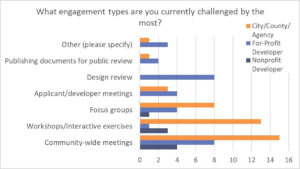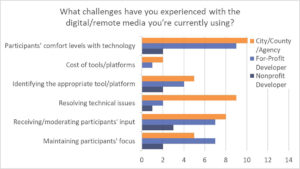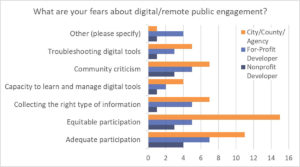By Alyssa Chung, Meredith Rupp, and Carla Violet, July 23, 2020
Remember when we could host 100+ people in community centers, serve communal refreshments, and stand close to each other to debate different planning scenarios? How easy we had it! What do these community engagement events look like now? What can we learn from planners who have adjusted their community engagement strategies to conform to social distancing protocols?

Our consulting firm started a dialogue with our clients and colleagues around stakeholder and community engagement during a pandemic (and beyond). Through an online survey and two virtual focus groups, we started collecting data to define the community engagement challenges planners and applicants are facing and collectively brainstorm effective, equitable, and safe solutions.
Before diving in, let’s define our terms:
- Community engagement: Activities and methods used deliberately to involve communities in the decisions that will affect them. Community engagement goes beyond noticing or informing the community, but the level of influence the community has varies depending on project goals and contexts (e.g., consulting the community for feedback on a few options versus designing the preferred option in partnership with the community).
- Socially-distant engagement: Any engagement method that allows participants to remain at least 6 feet apart and in groups of not more than 10 individuals, whether through carefully designed in-person engagement events (small focus groups outdoors, tables at Farmer’s markets), digital engagement methods (social media, online surveys), or other remote methods (phone calls, meetings-in-a-box).
Research methods
Urban Planning Partners asked approximately 100 of our clients and colleagues to complete an online survey in mid-May. We provided a week to respond and received almost 50 responses: 43 percent from City/County/Agency staff, 33 percent from for-profit developers, and 24 percent from non-profit developers. As we did not employ a random sample, we consider our findings as impressionistic data rather than statistical conclusions.
With the survey results in hand, we held two focus groups, one with approximately 20 public sector members (jurisdictions and regional agencies) and six with developers (both for-profit and non-profit, working on a range of project types and sizes).
Data and findings
Across all respondents, the most common difficulties with digital tools were (1) participants’ comfort level with technology, (2) maintaining participants’ focus, and (3) our receiving and moderating participants’ input. Fortunately, respondents were more excited about than afraid of remote engagement, including being eager to reach a wider audience and welcoming the convenience of digital and/or remote options.
We found some key difference between developer respondents and those in the public sector. Both groups felt most challenged by larger community-wide meetings. However, for-profit developers were just as challenged by design review, which was not identified as a challenge by any public sector staff respondents. The survey indicated developer respondents were also more concerned about community criticism than were public-sector staff.
Developers in our focus group expanded on this, saying they feared backlash from jurisdictions that may see digital-only engagement as inadequate. We discussed with them some alternatives and ways to build political support for projects, such as:
- Identifying and engaging community influencers, leaders, and decision-makers in one-on-one virtual meetings or in videos to post online
- Talking to and collecting signatures from passersby by staffing tables at the project site
- Creating walk-by workshops for small groups
- Attracting new audiences with meetings-in-a-box or scavenger hunts
Public sector staff were more likely than developer staff to be concerned about resolving technical issues. In our public sector focus group, we discussed best practices for remote engagement, such as:
- Using the chat feature to give and receive feedback
- Making the meetings more dynamic and organic by keeping meetings small
- Using Zoom’s questions and answers feature with larger groups
- Building relationships with attendees by opening remote meetings 15 minutes before the official time and/or keeping them open afterward
To ensure equitable participation and keep communities engaged, our focus group attendees were interested in low-tech and tech-free methods such as training community ambassadors, utilizing phone-based capacity-building for community organizations, and compensating community members. TikTok was identified as a good tool for reaching younger audiences and elevating community-created content.
So what?
When reflecting on what community engagement will look like for projects moving forward, consider the following:
- Community engagement practices, guidelines, or policies. Are your jurisdiction’s methods now obsolete or unachievable? Now’s the time to “translate” them to be more adaptable and fit our new reality. Focus on desired outcomes (e.g., input from a representative cross section of the community). Think performance standards. Be flexible — perhaps list approved engagement options for stakeholders in your jurisdiction.
- Equitable participation. Consider (1) compensating participants in community engagement efforts or (2) working with community organizations and service providers to reach underrepresented communities and works towards.
- Design review. How is that going in your jurisdiction? Our findings indicate a potential for better platforms, communication, or process improvements.
- Participants struggling with technology. Consider posting brief “How-to” tutorials or establishing a technical assistance telephone hotline for community members. Make sure your online engagement tools of choice are Smartphone-compatible for those without computers.
- Different engagement tools. Has anyone in your organization checked out what’s available? Our survey respondents were mostly familiar with Zoom, WebEx, and Microsoft Teams, yet reported challenges with workshops and interactive engagement exercises. Many GIS/Engagement platforms (such as MetroQuest, Poll Everywhere, and Bang the Table) are available with interactive capabilities.
We can help
Our firm, Urban Planning Partners, offers a Problem-Solving Series and updates. Sign up with achung@up-partners to receive best practices and research in your inbox.
About the authors
 Alyssa Chung is an assistant planner at Urban Planning Partners, where she helps support projects from CEQA to entitlements to policy. Born and raised in the Bay Area, she is passionate about serving her community through great planning. She holds a BS in city and regional planning from CalPoly, San Luis Obispo.
Alyssa Chung is an assistant planner at Urban Planning Partners, where she helps support projects from CEQA to entitlements to policy. Born and raised in the Bay Area, she is passionate about serving her community through great planning. She holds a BS in city and regional planning from CalPoly, San Luis Obispo.

Meredith Rupp is a senior planner at Urban Planning Partners, where she manages many of the firm’s housing policy and community engagement projects. Meredith has an MA in international policy and development from the Middlebury Institute of International Studies at Monterey (MIIS) and a BS in linguistics from Truman State University.
 Carla Violet, planning manager and senior planner at Urban Planning Partners, manages land use policy and CEQA projects. Her passion for urban planning grew from a desire to revitalize her hometown Oakland while protecting its diversity, arts scene, and activist roots. She earned her MS in community and regional planning from the University of Texas at Austin.
Carla Violet, planning manager and senior planner at Urban Planning Partners, manages land use policy and CEQA projects. Her passion for urban planning grew from a desire to revitalize her hometown Oakland while protecting its diversity, arts scene, and activist roots. She earned her MS in community and regional planning from the University of Texas at Austin.





